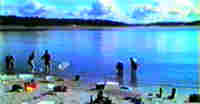|

They
are wonderful
|
|
A lot of food
Swarms of life attract many creatures.
Large fish, such as cod,
salmon
and plaice,
come up from the deep and wading birds make a stop to replenish their
energy supply. Birds are most active during sunrise and sunset, while
fish, crabs and many other of the beaches roaming bottom living animals
are most active at night.
During the autumn, most of the shores living animals migrate
to deeper water. During the stormy autumns and cold winters many die,
even in many other places than on the sand beaches. Therefore, the size
of the seaweed banks, and the variety of specie within, reach their peak
during the autumn.
Ice
Winter ice is dangerous for the shoreline
as it scrapes the shore and bottom, thus injuring the fauna that lives
there. The ice also prevents, or at least impedes oxygenation of the water,
water exchange at depth and many organisms can die due to the lack of
oxygen. But there are small microscopic organisms, mainly diatoms, that
can survive in many of the small cavities in and under the ice. These
small plants can supply some small animals with oxygen during the winter.
Reasons for variations in quantity and specie
What happens to the larvae out at sea,
and to adult individuals on the shore, affects population size and distribution.
Far too little is known about why a specific specie is found on a certain
beach, why they thrive on different parts of a beach and why populations
vary.
|

|
Page 14
of 15
|

|
|